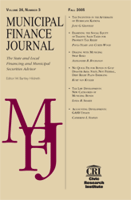Fiscal Implications of COVID-19 in Connecticut
Author: Mark D. Robbins.; Bill Simonsen.
Source: Volume 41, Number 02, Summer 2020 , pp.13-23(11)

< previous article |next article > |return to table of contents
Abstract:
Connecticut ended FY 2020 with a general fund surplus of about $39 million despite the economic impact of the COVID-19 pandemic. The state suffered during the Great Recession and as a result instituted some reforms that position it well to financially handle the COVID-19 recession, at least in the short-term. The state has a robust budget reserve, which now nominally stands at about 15% of general fund appropriations. However, a close look at the underlying financial reports suggests that a sizable amount does not exist in any real sense under GAAP accounting. The state is halfway through the current biennium, and assuming current projections hold, the budget reserve will be enough to cover the projected general fund deficit. The larger challenge is likely to be the next biennium, which projections suggest will have a substantial deficit, expiring labor contracts, and large unfunded fixed costs for pensions and other postemployment benefits (OPEB), along with substantial bonded debt. State officials will likely face the next biennium’s deficit with little or no budget reserve.Keywords: Connecticut, state budgeting, COVID-19, state response to recessions, public budgeting
Affiliations:
1: University of Connecticut; 2: University of Connecticut.